
The Pork Katsu Sando from Chinatown’s Katsu Sando. The restaurant’s second location is expected to open in San Gabriel this year.
(Mariah Tauger / Los Angeles Times)
The most affordable from The Times’ list of 101 Best Restaurants in L.A.
- Share via
Perhaps the truest glory of dining in Los Angeles is that a street-side taco can equal a white-tablecloth tasting menu in complexity and pleasure. In a season driven by flagrant spending, it’s always a good moment to highlight the most affordable restaurants from our annual 101 Best Restaurants guide. Whether they serve burritos, za’atar-dusted Lebanese flatbreads, noodles, dumplings, bubbling tofu stews or smash burgers, their deliciousness and cultural significance far outweigh their cost.
Showing Places
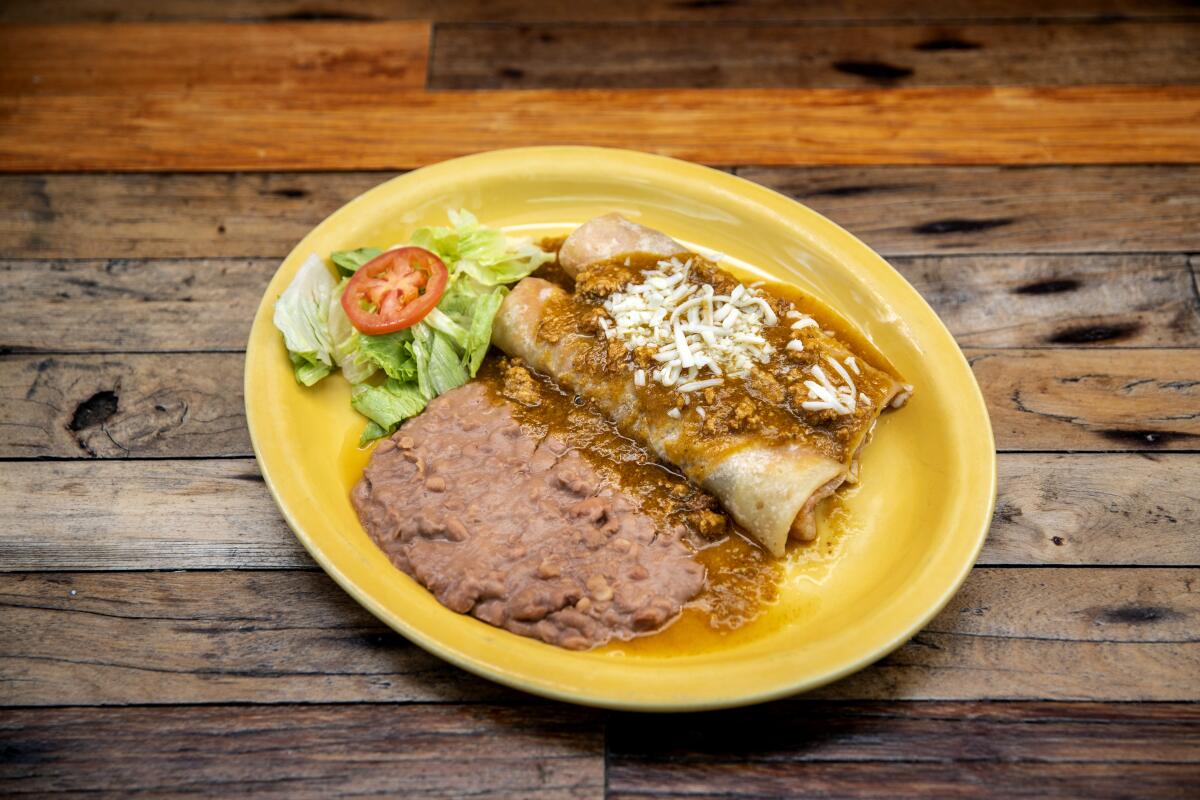
(Jay L. Clendenin / Los Angeles Times)
Burritos La Palma
El Monte Mexican
Overstuffed burritos, with their nap-inducing surge of big flavors and lulling textures, have obvious pleasures. But equal beauty lies in the compact burritos you can easily wrap one hand around — bundles filled with stews, or complementary pairs like frijoles and cheese, in which you can taste the quality and care in spicing. The Bañuelos Lugo family are masters of the tightly packaged burrito. They began their business in Zacatecas, Mexico, in 1980. At each of their four Southern California locations, handmade tortillas crisp on the griddle; they parcel one of a half-dozen options for fillings, including deshebrada (shredded beef in bright, tangy green chile) or duskier chicken tinga with potato. If you are looking to be satiated to the point of stupor, there is always the platillo especial, two birria-packed burritos in a swirl of green chile and stringy cheese.
Read All Read Less
Route Details
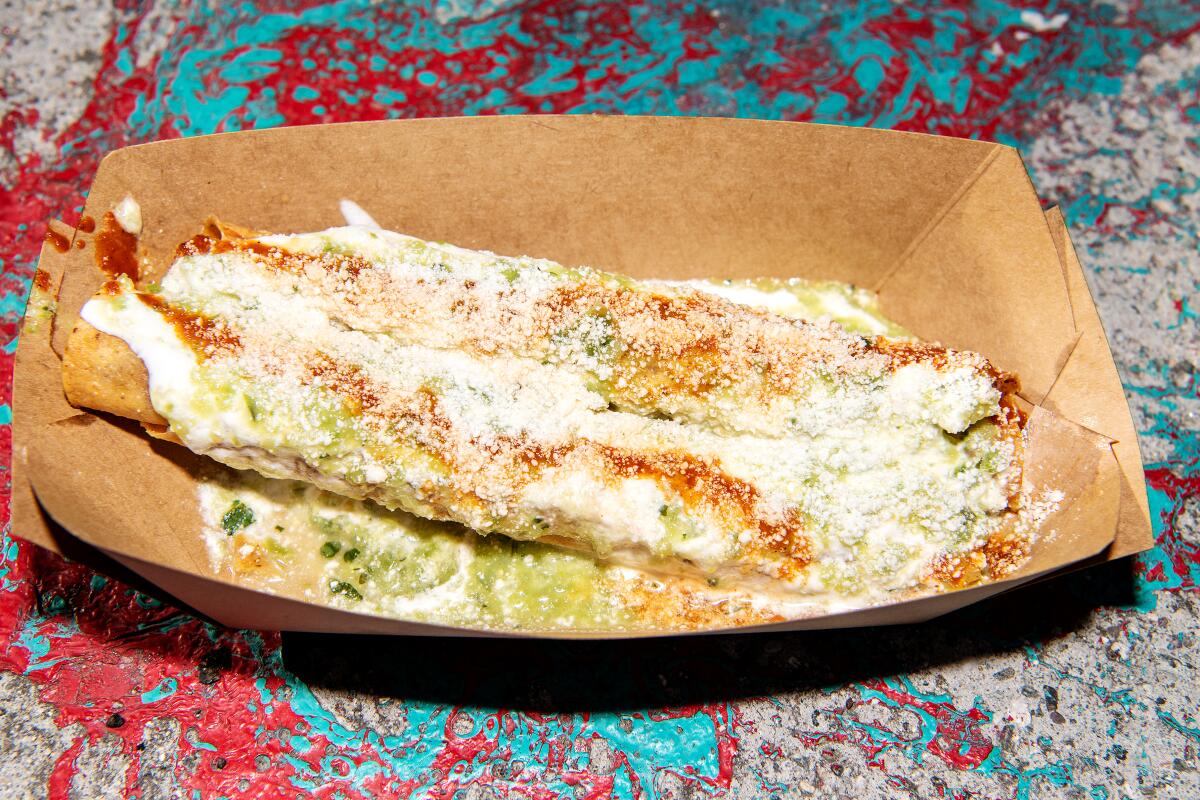
(Mariah Tauger / Los Angeles Times)
Los Dorados
Mexican
From a sky-blue trailer painted with overlapping murals and occasionally sporting a disco ball, Steven Orozco Torres serves tacos dorados (a.k.a. flautas) in four variations. Chicken tinga hums with chipotle; lamb barbacoa nestles under a sauce that resembles mole negro and tastes distinctly of beer; chorizo con papa balances spicy, meaty and creamy; and a vegetarian mashed potato dissolves into soft, cumulous textures. No matter which you choose — and you probably should try them all — the effect is the same: The rolled, fried tortilla crackles satisfyingly against the teeth, cuing an endorphin rush. Crema twangs on the palate, and the finishing touch of crumbled cotija whips around like a salty snow flurry. It’s all a master class in flauta engineering. Los Dorados lists its locations (mostly Friday through Sunday) on Instagram weekly. Torres, a former bartender, often parks in front of bars and breweries. Needless to say, dorados make for excellent drinking food.
Read All Read Less
Details

(Mariah Tauger / Los Angeles Times)
Evil Cooks
El Sereno Mexican
On Friday and Saturday nights in El Sereno, and on Sunday mornings at Smorgasburg at Row DTLA, Alex Garcia and Elvia Huerta arrive in their onyx-colored van and set up tents from which to serve their rowdily themed “hell menu.” In collaborations like the dessert flan taco — in which a tortilla with the delicate texture of a thin johnnycake cradles a citrusy slab of custard — the pair bring unceasing imagination to their mobile taqueria. Their chilaquiles breakfast burrito also makes an excellent dinner. The centerpiece of the operation, though, is three trompos stacked with pork, beef or octopus, each rubbed with “black pastor,” their rendering of an inky paste of charred chiles called recado negro. Garcia and Huerta nicknamed the novel octopus al pastor “Poseidon.” It looks sentient, like something from one of the more demonic scenes on “Lovecraft Country.” But carved into corn tortillas, dressed with pickled onions, red salsa and guacamole and sweetened with a sliver of charred pineapple, the taste is holy.
Read All Read Less
Route Details
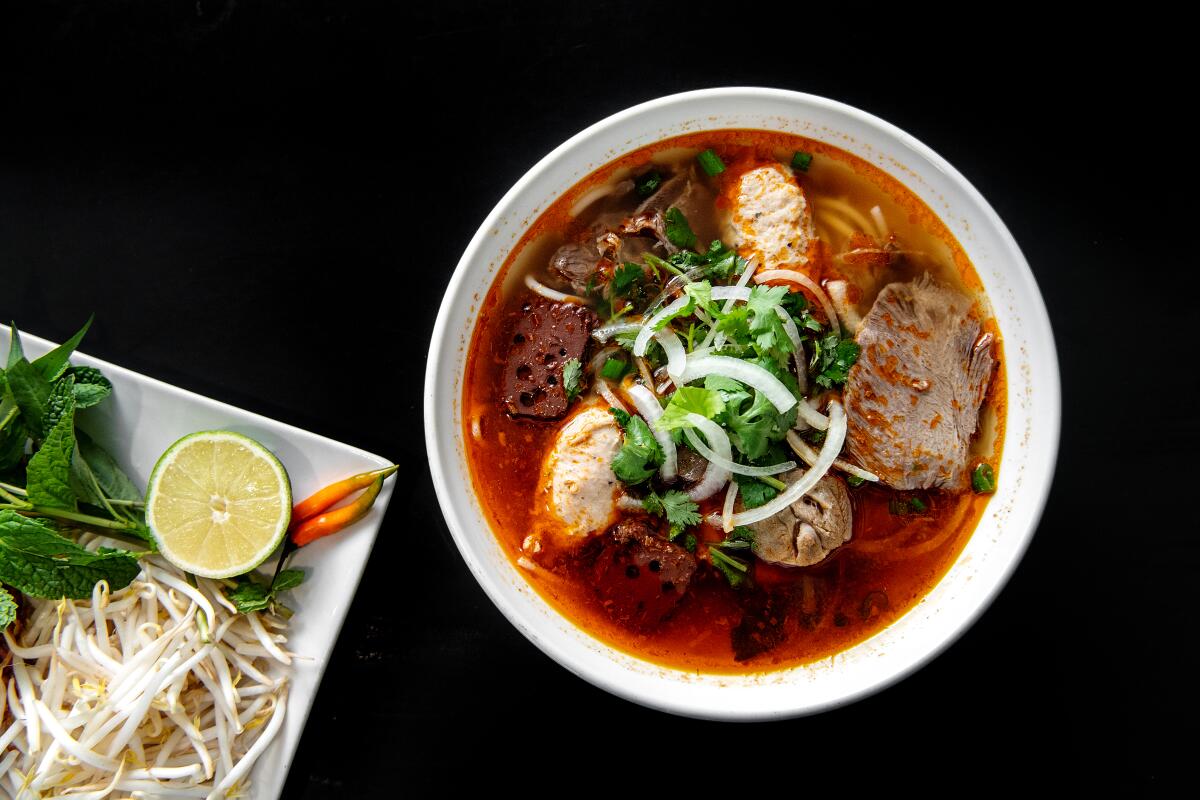
(Mariah Tauger / Los Angeles Times)
5 Stars Hue
El Monte Vietnamese
Among the abundance of Vietnamese glories in the San Gabriel Valley — the many options for pho, banh mi, crepes, rolls and broken rice plates — I’ve been fixated on bánh ít kẹp bánh ram (also seen on menus as bánh ít ram or bánh ram ít). It’s a two-part dumpling of glutinous rice dough filled with shrimp and pork and then set on a disc of lacy fried dough. It crackles, it squishes, it bursts; it’s awesome. At 5 Stars Hue, a small but growing chain of restaurants located throughout the SGV, the bánh ram ít are powerful in their crisp-soft contrasts, and liberal splashes of nuoc mam take the flavors to fresh, pungent extremes. Round out the meal with bún bò hue, the spicy beef noodle soup with scarlet broth and ruby blood cakes as soft as tofu, designed to be customized with herbs and lime and tangles of fresh and fried onions.
Read All Read Less
Route Details
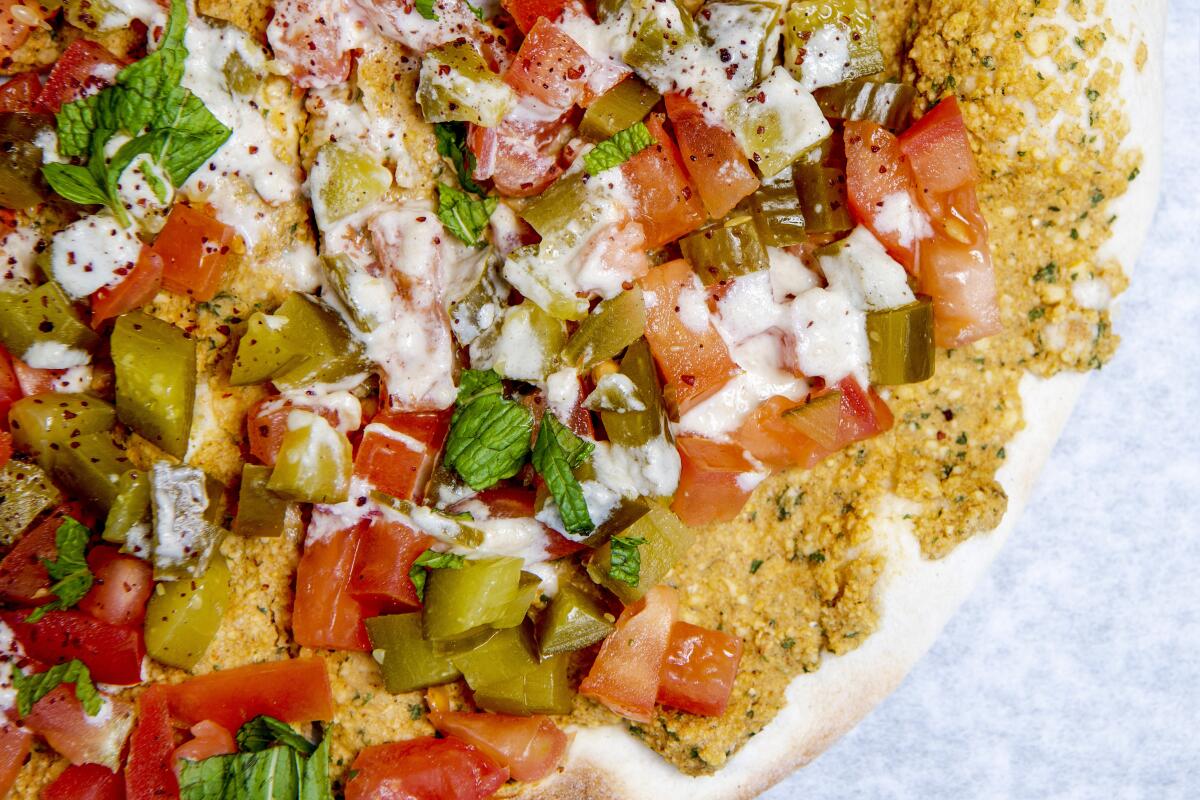
(Mariah Tauger / Los Angeles Times)
Forn Al Hara
Anaheim Lebanese
Manakeesh (or man’oushé, in its singular form) is one of the world’s great flatbread traditions — discs of thin, speckled dough cranked out by corner bakeries for breakfast all over Lebanon. Mo Alam, a native of Tripoli, the second-largest city in Lebanon, has been serving Southern California’s finest manakeesh to Anaheim’s Little Arabia community for 20 years. The version spread with the pine-green, sesame-speckled mix of za’atar and olive is the traditional baseline; diverge from there to nearly three dozen ingredient combinations. A man’oushé with eggs and soujouk (cured, cumin-scented beef sausage) makes for an ample morning meal, as does lahm bi ajeen overlaid with spiced ground beef flavored with pomegranate molasses. Buy some fatayer (triangular pastries filled with lemony spinach) and ma’amoul (crumbly cookies filled with dates or nuts) for later.
Read All Read Less
Route Details
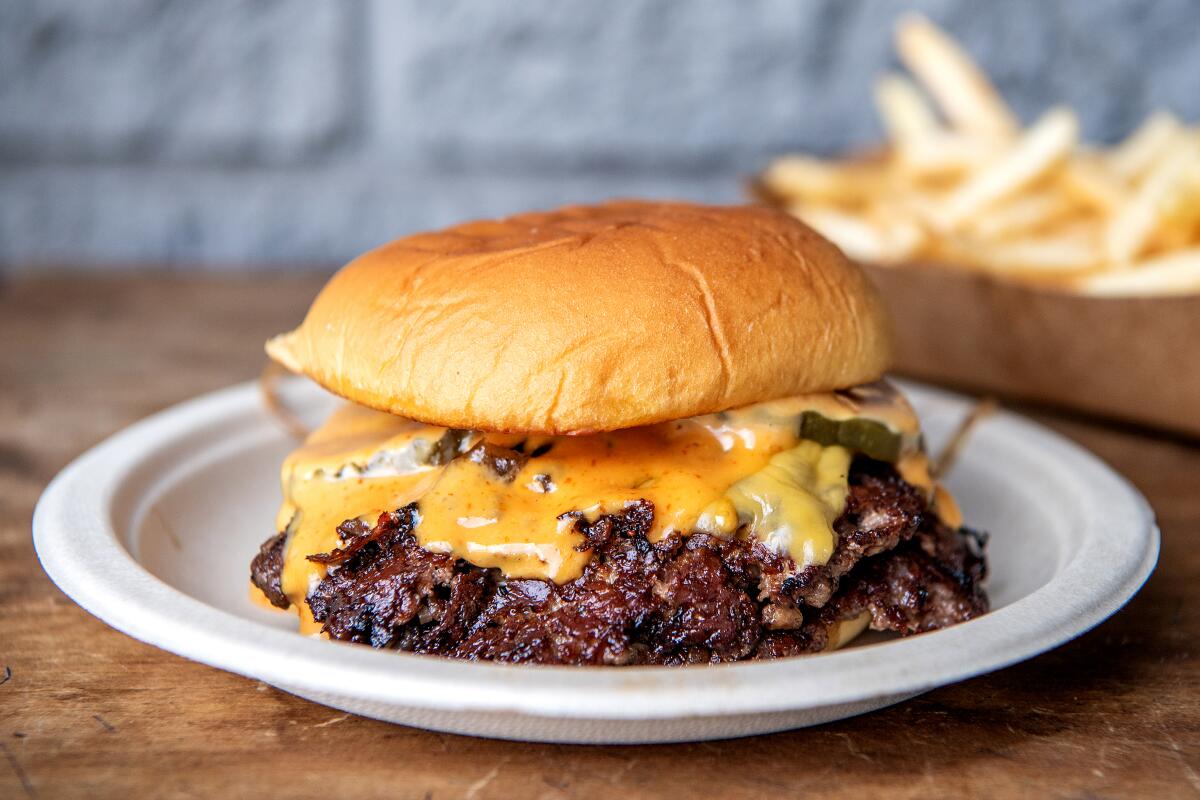
(Mariah Tauger / Los Angeles Times)
For the Win
Hollywood Hills Burgers
The procession of new burgers in Los Angeles marches onward tirelessly; I keep pace with the latest entrants but find myself lately circling back to For the Win. In summer 2020, Santos Uy made the decision to convert his edge-of-Hollywood Hills bistro Papilles to a smash-burger joint. He built a timeless model that purrs from fine-tuning: flattened, crisped patties on a Martin’s potato roll with American cheese and Thousand Island-ish sauce melting into oneness. Griddled onions dangle off the side like commas, reminding you to pause between bites. I ask for a double, sometimes with crackly bacon added, but its presence doesn’t feel crucial. There is the option of a patty melt, and skinny fries or frizzled Brussels sprouts as sides, but the smash burger’s the thing. If you’re really hungry, make it a triple.
Read All Read Less
Route Details
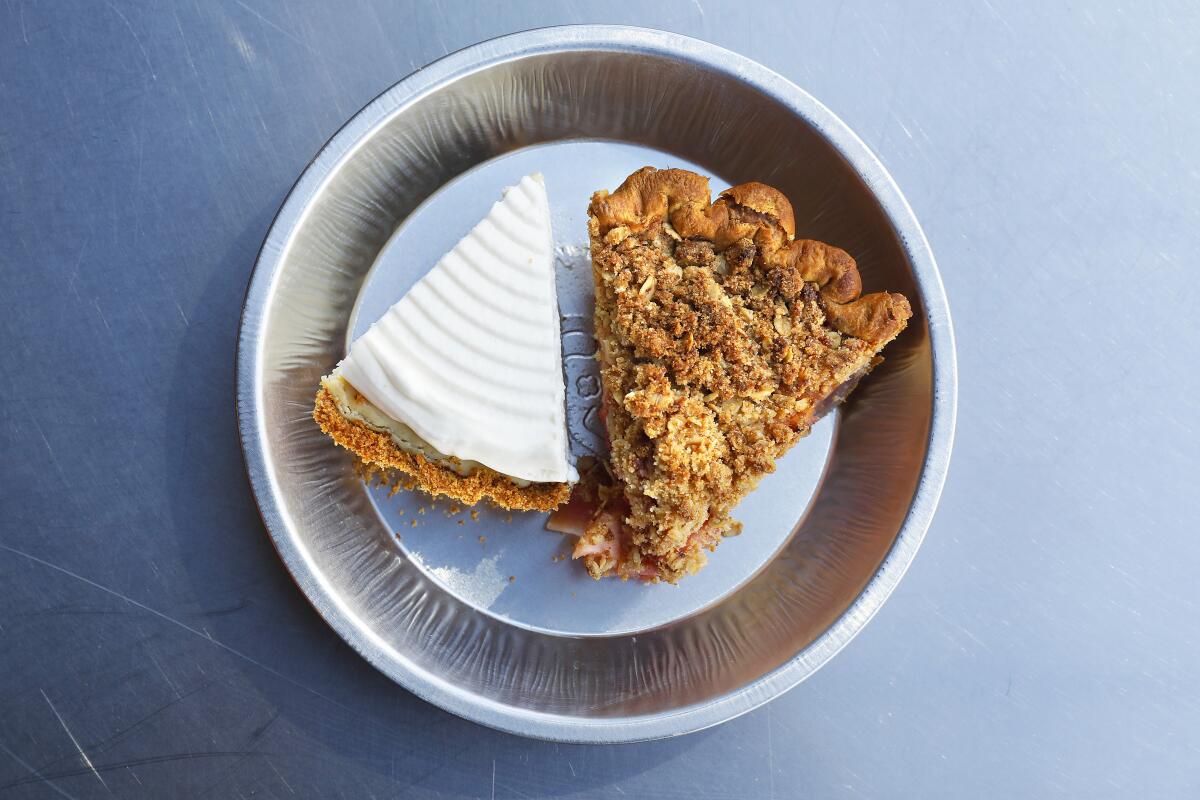
(Christina House / Los Angeles Times)
Grand Central Market
Downtown L.A. Eclectic
The name of downtown Los Angeles’ 104-year-old landmark, which has stood now through two global pandemics, feels entirely fitting again. On weekends especially, you’re not so much walking among the vendors and neon signs as being swept along, like the surge through exits at the end of a Lakers game. As ever, the market stands at the crossroads of what the city has been and what it is becoming. Grab a gordita filled with cabeza from Roast to Go, in operation since 1952, and pair it with crisp-creamy pupusas revueltas from Sarita’s Pupuseria. As to the future: I direct you to the southeast corner of the building and two of GCM’s newest tenants. Shiku, meaning “family” in Korean, comes from Baroo Canteen’s Kwang Uh and Mina Park. Their new project revolves around an ever-changing selection of banchan and to-go meals such as fried rice with spicy and citrusy “kimchi’d corn,” fried egg and potato chips. Next door to them is the freshly tiled stand for Fat + Flour, the pie shop (but also cookies!) from superstar baker Nicole Rucker.
Read All Read Less
Route Details
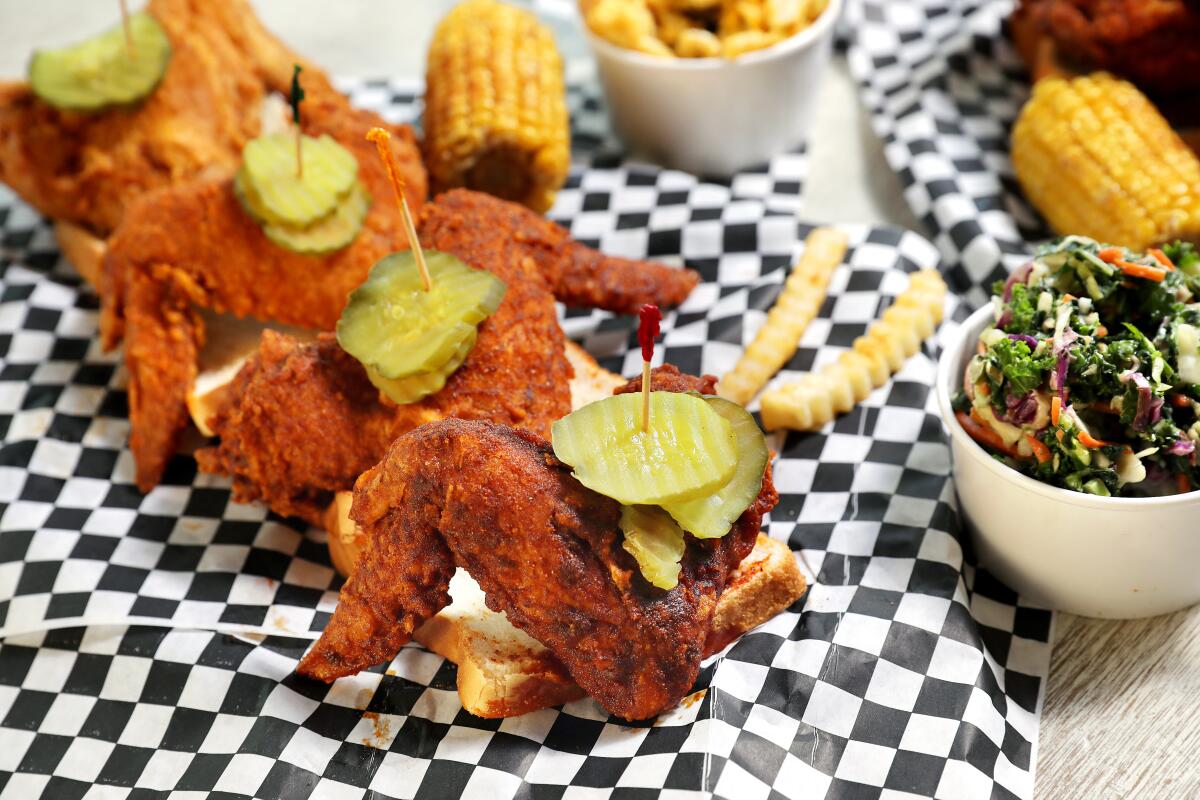
(Christina House / Los Angeles Times)
Hotville Chicken
Baldwin Hills/Crenshaw American
When Kim Prince opened her restaurant at the Baldwin Hills Crenshaw mall in December 2019, she brought a taste of Nashville-style hot chicken’s true lineage to Los Angeles. Her aunt is André Prince Jeffries, owner of Prince’s Hot Chicken in Nashville; their family began selling hot chicken to Music City customers in the 1940s. Come to Hotville to understand why this torturous pleasure became a national phenomenon. The staff begs first-timers to order mild; with medium and certainly spicy you cross into the territory of tingling, maybe even an all-over prickling sensation, and sweats. You will want more. For hot chicken sandwich seekers, Prince makes a slaw-crowned version she calls the Shaw, and on weekends the kitchen sends out buttery waffles to quell the bird’s burn.
Read All Read Less
Route Details

(Mariah Tauger / Los Angeles Times)
Joy
Highland Park Taiwanese
Vivian Ku’s two restaurants, Pine & Crane in Silver Lake and Joy in Highland Park, have become neighborhood fixtures through their fast-casual airiness and the lightness of the Taiwanese dishes they serve. The subtle flavors and emphasis on vegetables have never been a play at oversimplifying the cuisine; those traits specifically channel the cooking style of Ku’s maternal grandmother, Fang Chiu Chen, a constant muse in her approach to food. Both places feature a changing array of cold salads (inky wood ear mushrooms, crunchy-soft braised peanuts) and serve lu rou fan, a classic comfort dish of nubbly, sweetly spiced pork over rice with tea egg and crisp pickled daikon. Joy’s menu is ingeniously concise: a few soups and bowls of noodles, a couple of other wonderful rice dishes, half a dozen riffs on sandwiches. I love the shallot-spiked chicken rice that’s popular in Chiayi, a city in southwestern Taiwan. Take a couple of bites to appreciate its purity, and then douse it with chile oil. A final notch for Joy: mochi rolled in crushed peanut and black sesame, a dessert that’s a Hakka specialty and a favorite of Ku’s father’s.
Read All Read Less
Route Details

(Mariah Tauger / Los Angeles Times)
Katsu Sando
Chinatown Japanese
Daniel Son and his partners are aiming to open a second, larger location of Katsu Sando in San Gabriel in 2022. The frequent weekend specials at the Chinatown original, detailed on the takeout shop’s Instagram account, likely foreshadow what the team has in the works. Their riffs on kakigori, the Japanese style of shaved ice that’s having a moment across America, lean into seasonal produce and charming themes; spiced kabocha syrup, chocolate and candy corn graced a Halloween-inspired version. We should collectively lobby to make the pork katsu sando variation with shiso and stretchy mozzarella a menu mainstay. Meanwhile, there is always the honey walnut shrimp sando, a marvel of design that’s often creamy and crisp in the same bite. Speaking of studies in texture: Grab an onigiri from the to-go case, and, for a buck extra, ask the staff to fry it katsu-style, and then dunk it in a side of curry dip.
Read All Read Less
Route Details
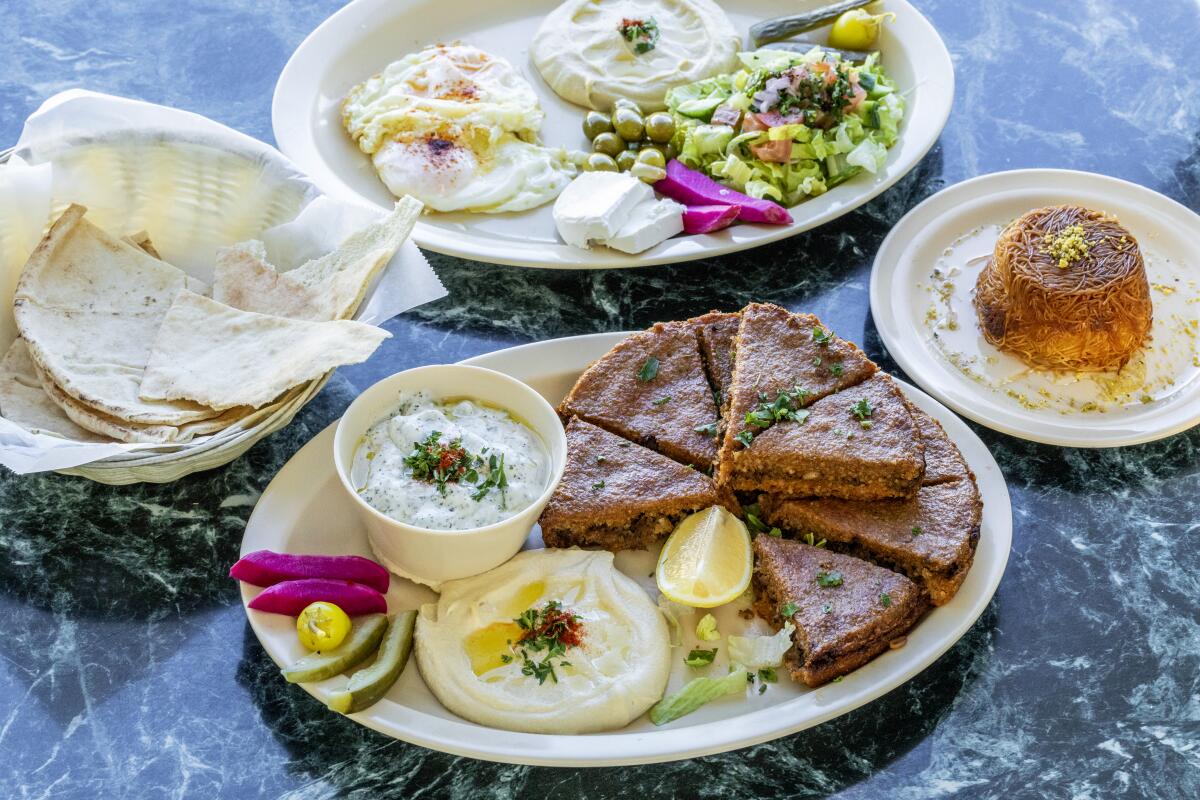
(Ricardo DeAratanha / Los Angeles Times)
Kobee Factory
Van Nuys Syrian
At the Lebanese and Armenian-Lebanese restaurants in Los Angeles, you may have tried fried kibbeh, the football-shaped spheroids of spiced ground beef and bulgur that, when cracked open, reveal a filling riddled with pine nuts. At her Syrian restaurant in Van Nuys, Waha Ghreir serves a barbecued version, patties branded with grill marks that take on a pleasantly bouncy texture. She also makes kibbeh bil sanieh — a baked version, sharper in its contrasts between soft and crackling, that’s a favorite comfort food of my Lebanese friends’. The menu opens a few more windows into Syrian cuisine, a woefully underrepresented cuisine in Southern California: mujadara (bulgur and lentil pilaf scattered with deeply caramelized onions); frankly delicious intestines stuffed with ground beef and rice, presented in a broth scented with allspice, cinnamon and bay leaf; and fava beans creamy with garlicky tahini for breakfast.
Read All Read Less
Route Details
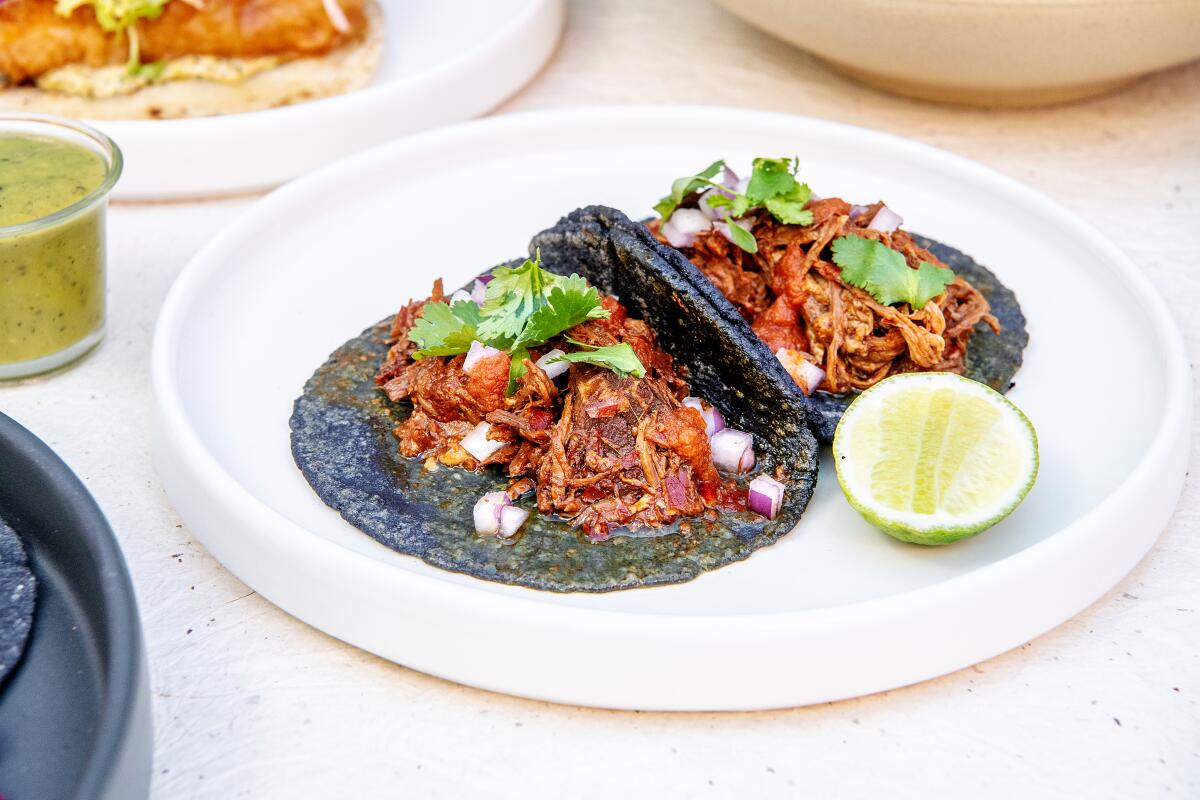
(Mariah Tauger / Los Angeles Times)
Macheen at Milpa Grille
Boyle Heights Mexican
In September 2020, Jonathan Perez settled his roving taquería into an open-ended breakfast and lunch residency at Milpa Grille in Boyle Heights. His inventive tacos tend to follow a winning outline: complex, saucy and blasted with acid. One example: A plank of pork belly, its crisped edges tingling with red chile and vinegar, flops over its tortilla. Refried black beans billow around the pork in churning clouds; avocado salsa and grilled cactus lighten the landscape. His breakfast burritos are among my favorites in the city (and I’ve eaten my share). Perez lines flour tortillas with creamy scrambled eggs enriched with nutty Swiss cheese and then piles on spiced, deep-fried Tater Tots. Meaty options include birria with chipotle aioli, pork belly with avocado salsa and (the standout) Filipino longanisa with salsa macha. For vegetarians, there are Brussels sprouts frizzled to papery curls and glossed with chipotle aioli.
Read All Read Less
Route Details
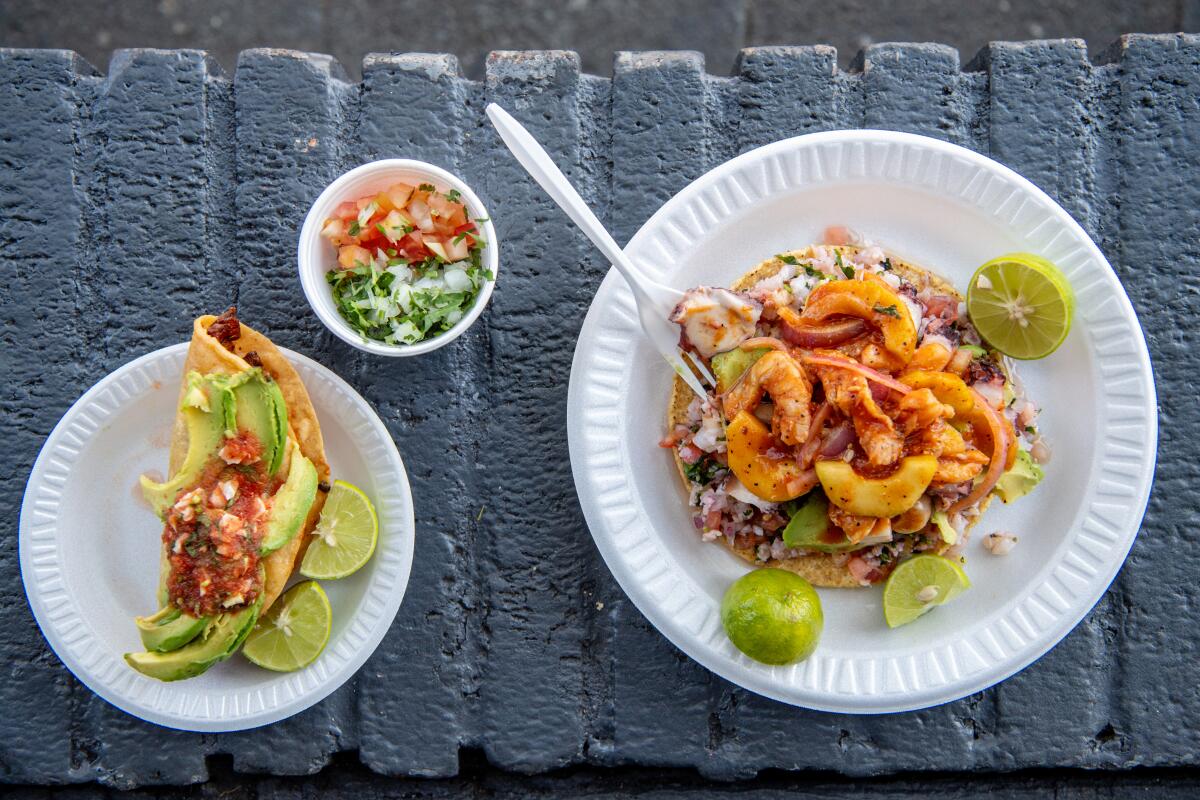
(Mariah Tauger / Los Angeles Times)
Mariscos Jalisco
Boyle Heights Mexican
When a friend who’s a native Angeleno came to town in May to see family and friends for the first time since the pandemic began, she had a request: Can we go to Mariscos Jalisco? Absolutely. Since 2002, Raul Ortega has been parking his shiny lonchera on Olympic Boulevard, serving what has become one of the city’s canonic dishes: tacos dorados de camaron. Two fried corn tortillas grip spiced shrimp that maintain a mysterious creaminess (Ortega gives away no secrets) even as their edges crisp a bit in hot oil. A thin tomato salsa, its juices already soaking into the hot masa, blankets the top with avocado slices. Don’t delay, don’t take them elsewhere: Wolf them down right there, perched on the short, painted brick wall in front of the truck. For variety’s sake, order the Poseidon, an aguachile-ceviche mashup of shrimp, octopus, cucumber, avocado and tomato finished in a scorching salsa. My friend and I? We asked for another round of tacos.
Read All Read Less
Route Details
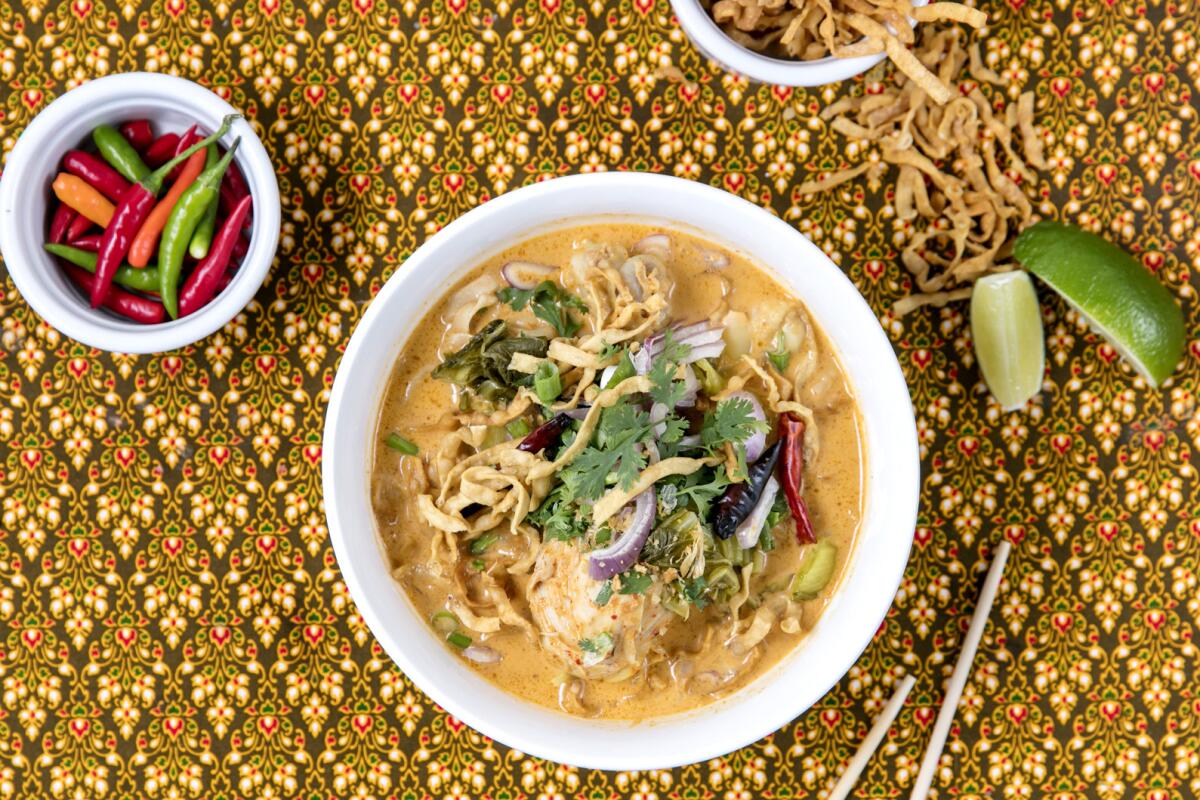
(Silvia Razgova / For the Times)
Northern Thai Food Club
East Hollywood Thai
Pre-pandemic, a big part of the pleasure of eating at “Nancy” Amphai Dunne’s 12-seat restaurant in Thai Town was interacting with her over the steam table. You’d converse about the daily specials inspired by the cooking of Chiang Rai, Thailand’s northernmost province, where Dunne grew up. She standardized the menu for online ordering last year. The dishes on which she made her reputation are easy to identify: sai ua, rough-textured pork sausages packed with minced lemon grass; garlicky green mango salad; gaeng hung lay, pork belly curry with the attuned sour-sweetness of tamarind and julienned ginger. It also makes it easier to choose something new to try — say, gaeng kanoon, a soup with lobes of jackfruit, pork ribs and cha-om, an herb that resembles dill and, when cooked, has a vegetable earthiness that almost veers almondy.
Read All Read Less
Route Details
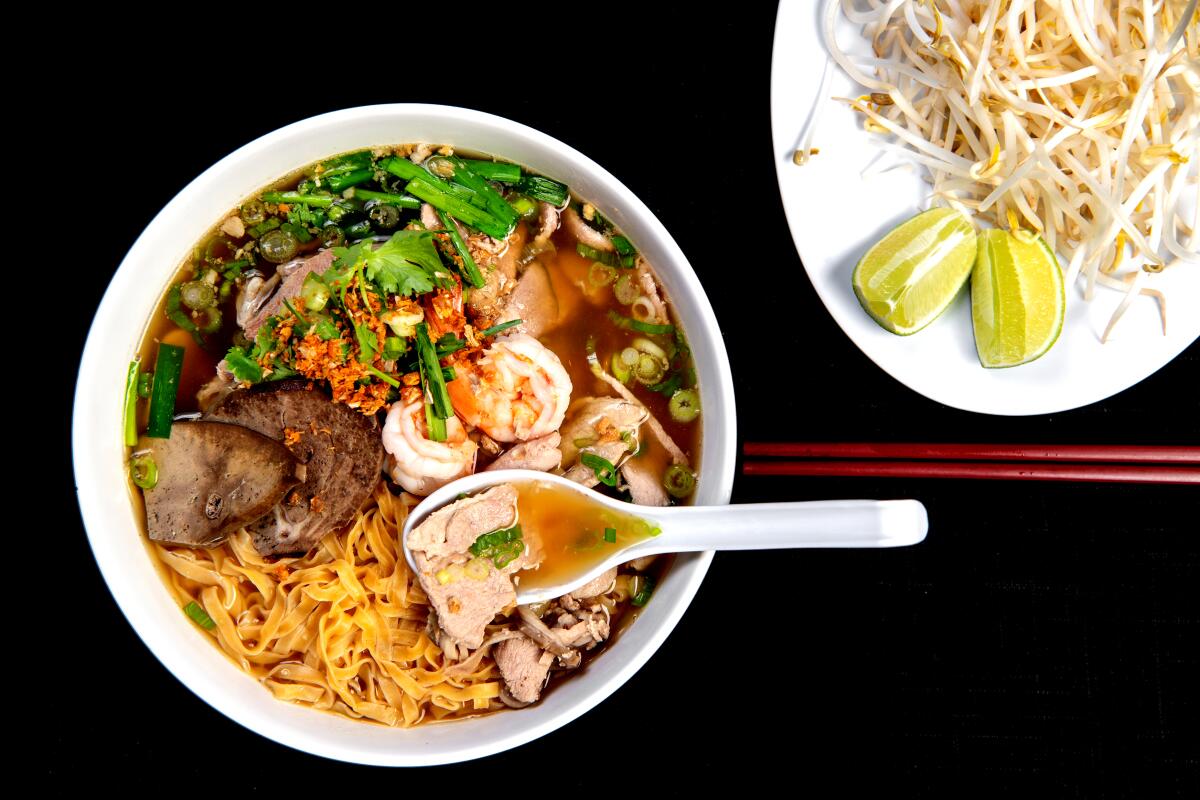
(Mariah Tauger / Los Angeles Times)
Phnom Penh Noodle Shack
Long Beach Cambodian
Any conversation about the dining culture in Long Beach’s Cambodian community (the largest in America) begins with Phnom Penh Noodle Shack, run by the second generation of the Tan family, which opened the restaurant in 1985. The patient crowds have reappeared in the mornings and afternoons, waiting for a table inside and for their bowls of kuy teav — highly customizable breakfast soup built around various shapes of rice or egg noodles and pork broth. Wade in with the multitextured house special (it includes several cuts of pork and shrimp), given even more nuance with the optional mixed noodles. Be lavish when adding garnishes of fried garlic and scallions and squeezes of lime. Nom sa-kieu, a savory turnover reminiscent of an empanada filled with a peppery tangle of onions and pork, makes an excellent side snack. And if this is indeed the day’s first meal, the iced coffee with sweetened condensed milk will jolt you into lucid consciousness.
Read All Read Less
Route Details
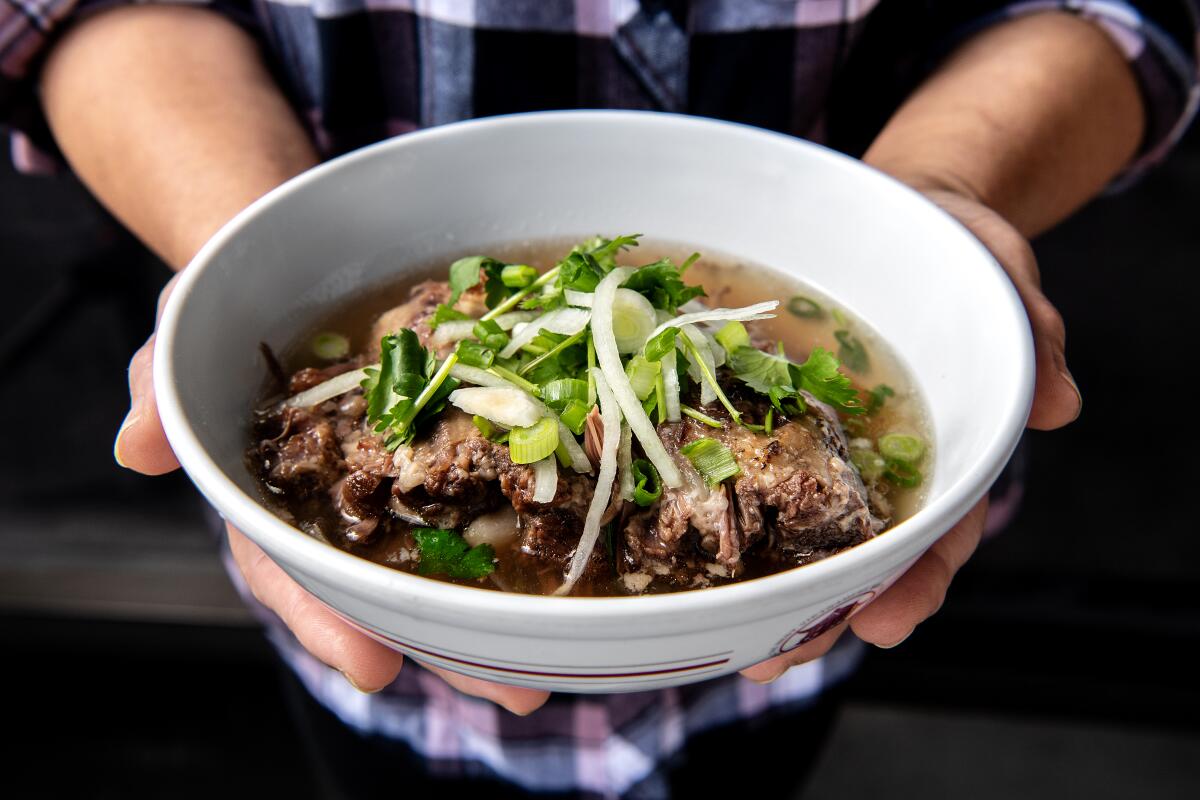
(Mariah Tauger / Los Angeles Times)
Pho 79
Garden Grove Vietnamese
Pho 79 is on the eve of its 40th anniversary: Liễu Trần and Thọ Trần opened the Garden Grove restaurant in 1982, and members of the same family continue to run the business. Among the hundreds of places in Little Saigon that have opened in the ensuing decades to express the breadth of Vietnamese culinary culture, the cornerstone dish at Pho 79 is still outstanding. Star anise and richly browned onions sweeten and balance the broth. No matter how you personalize it — whether you prefer tripe or meatballs or ask for the ribbons of round steak rare or well done — the addition of long-simmered oxtail meat pulled easily from the bone is clutch. Each day’s quantity is finite; plan to arrive before 12:30 p.m.
Read All Read Less
Route Details
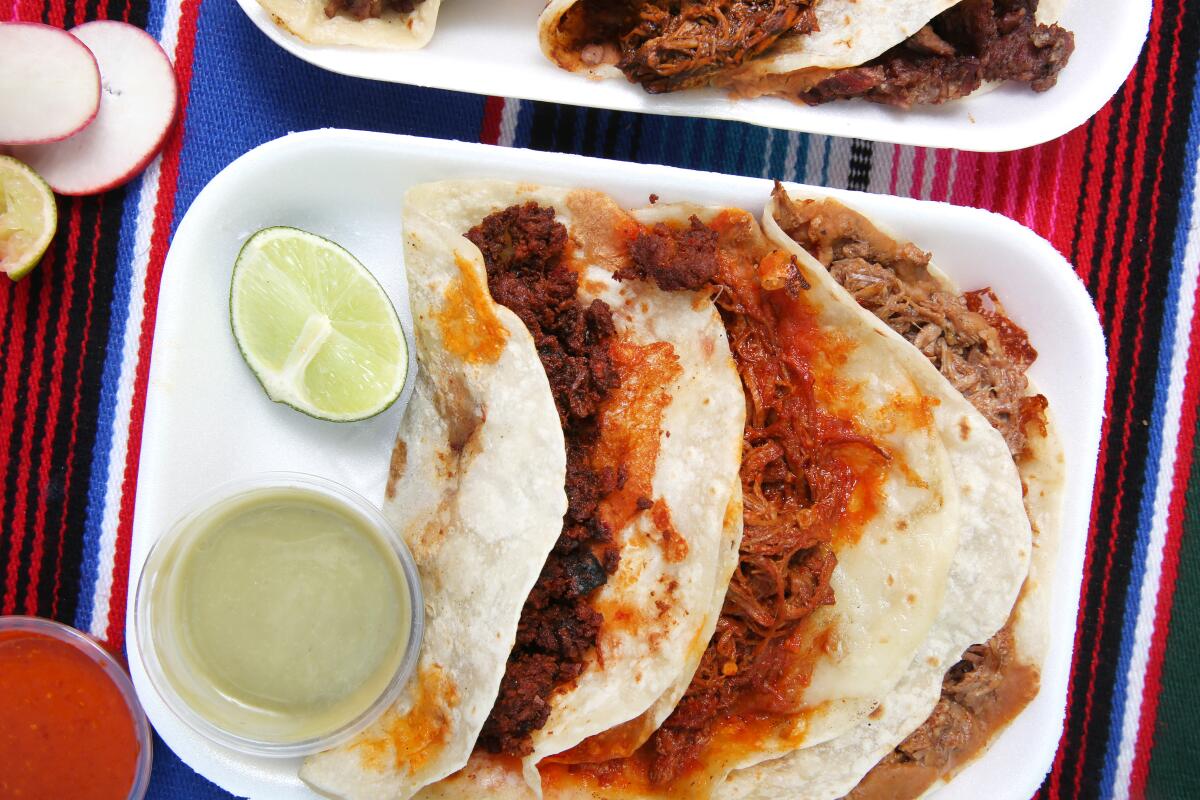
(Dania Maxwell / Los Angeles Times)
El Ruso
Silver Lake Mexican
The twin talents of taquero Walter Soto and tortilla master Julia Silva — who combine culinary traditions from Sonora, Sinaloa and Baja California — have made El Ruso a crucial stop on the Los Angeles taco circuit. Recently, they relocated their silver taco trailer from Boyle Heights to the corner of Sunset Boulevard and Descanso Drive in Silver Lake. The tacos are at their height when Soto is at the helm: soldering shredded cheese to tortillas on the griddle, overseeing the signature carne asada grilling amid plumes of mesquite smoke, and toying with specials like smoky-chewy tacos made with agujas (bone-in beef rib). Still, El Ruso’s greatest contribution to L.A. has arguably been the sobaquera, a specialty of Silva’s native Sonora. Her flour tortilla is stretched to the size of a dinner plate and then folded like a burrito around various meats. Ask for chile colorado, a bright red stew of beef infused with chiles and cooked to feathery shreds. The color bleeds through the tortilla and stains your mouth after every bite. It’s glorious.
Read All Read Less
Route Details

(Silvia Razgova / For The Times)
Sonoratown
Downtown L.A. Mexican
I don’t need to direct you to pause when you bite into one of Teodoro Diaz-Rodriguez Jr.’s flour tortillas to consider its merits. It happens almost involuntarily. The brain says this is different. You might flash on the most expertly stretchy dumpling wrapper you’ve ever tasted, or the rare pie crust that is at once flaky and buttery, but you’ll also never forget this is a tortilla. Diaz-Rodriguez brought the style from his hometown of San Luis Río Colorado in Sonora, Mexico. A marriage of Sonoran wheat and pork lard, it is basically perfect. Carne asada, the smoke and fire of the grill having seeped into the beef’s molecules, is the meat of choice. Which form do you prefer: taco, quesadilla, a folded caramelo, the mini-bundle of a chimichanga? I enjoy them all but return most to the famous Burrito 2.0, filled out with roughly mashed guacamole, Monterey Jack, sharply spicy chiltepin salsa and pinto beans.
Read All Read Less
Route Details
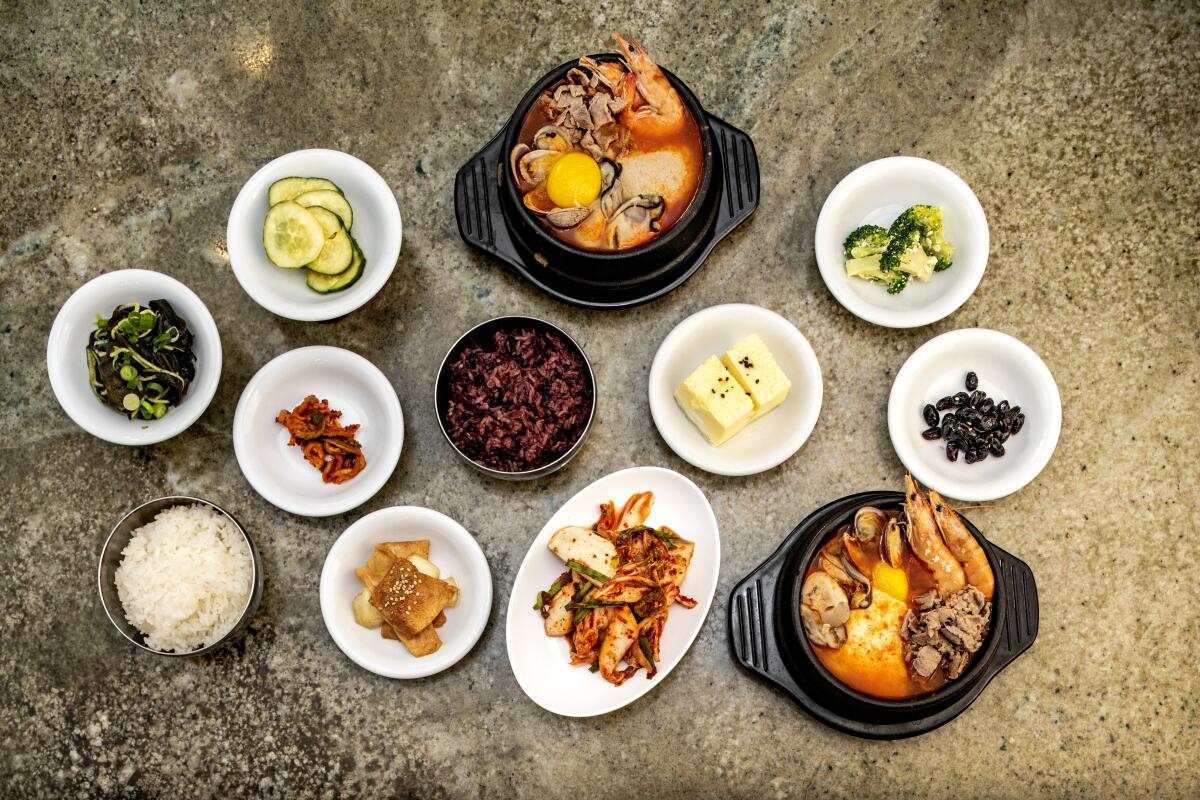
(Ricardo DeAratanha / Los Angeles Times)
Surawon Tofu House
Koreatown Korean
Even through a constant barrage of bad news, when Beverly Soon Tofu announced it was closing in September 2020, the loss of such a community anchor felt freshly jarring. Monica Lee opened the Koreatown restaurant in 1986, breaking new ground as a specialist in soondubu jjigae. Nothing (or no one) ever quite replaces a loss, but if you’re in need of the comfort of soft tofu stew, eating at Surawon Tofu House is good medicine. The restaurant makes its own tofu, and the menu presents over a dozen options for customization, including additions of vegetarian dumplings, kimchi, ox bone, oysters, intestines and an assorted mix of beef or pork with seafood. Choose among five levels of heat, from “plain” to “extra spicy”; I find “spicy” to be pulse-quickening but not brutal. The cauldron of stew arrives, boiling volcanically. You can pretty much intuit the moment when the jjigae is cool enough to sip. The chile stings your lips. The tofu melts on the tongue. And soon the bowl is empty.
Read All Read Less
Route Details

(Mariah Tauger / Los Angeles Times)
Tamales Elena y Antojitos
Bell Gardens Mexican
Before discussing the namesake tamales, the pozole verde must be extolled. Maria Elena Lorenzo, the matriarch of the family that runs the restaurant, adds both pork and chicken to the stock before stirring in a puree of tomatillos, serranos, pumpkin seeds, cilantro and other herbs. It tints the soup the pale green of Hass avocado flesh. A dizzying number of condiments follows, including customizations like fried tortillas that you break into shards and scatter with chicharrones. The style of the pozole, as with the rest of the menu, is specific to the Afro-Mexican cuisine of Costa Chica, part of the southern coastal state of Guerrero. The Guerrero-style tamales — which Lorenzo, husband Juan Irra and their five daughters began selling in Watts from carts and then a truck almost 15 years ago — are delicate masa rectangles, filled with pork in red salsa or chicken in green salsa and steamed in banana leaves. Eat several of them on the Bell Gardens restaurant’s small, beautifully tiled patio (although drive-through service is also an option).
Read All Read Less
Route Details
Eat your way across L.A.
Get our weekly Tasting Notes newsletter for reviews, news and more.
You may occasionally receive promotional content from the Los Angeles Times.







